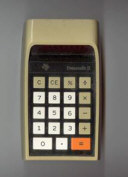
DATAMATH CALCULATOR MUSEUM
 |
DATAMATH CALCULATOR MUSEUM |
Texas Instruments Lesefreund
| Date of introduction: | 1988 | Display technology: | n.a. |
| New price: | Display size: | ||
| Size: | 12.0" x 21.5" x 1.7" | ||
| Weight: | 2 pounds 13 ounces | Serial No: | |
| Batteries: | 4*AA cells | Date of manufacture: | wk 31 year 1990 |
| AC-Adapter: | Origin of manufacture: | USA | |
| Precision: | Integrated circuits: | TSP50C42 (CSM42025), TSP60C19 (CMM19018), TSP60C19 (CMM19028) |
|
| Memories: | |||
| Program steps: | Courtesy of: | Joerg Woerner | |
| Download manuals: | |
 Nothing
else than the German edition of the Super Speak & Read
and the Ready...Set...Read!
game.
Nothing
else than the German edition of the Super Speak & Read
and the Ready...Set...Read!
game.
The picture on the left side displays the game in the closed state. Find a picture of the opened toy here.
Dismantling
a Lesefreund manufactured in July 1990 by Texas Instruments in the United States reveals a very efficient internal construction centered around a TSP50C4X
Speech Synthesizer and supported with two TSP60C19
Speech-ROMs compared to the TSP60C80 located in the original Ready...Set...Read!.
We located on the double-sided printed circuit
board (PCB) three Integrated Circuits:
|
• TSP50C42/CSM42025: TSP50C50 VSP (Voice Synthesis Processor) with 8-bit microcontroller and 8k Bytes Mask ROM for both program and voice and
128 Bytes + 16 Nibbles RAM • TSP60C19/CMM19018: VSM (Voice Synthesis Memory) with 256k Bits • TSP60C19/CMM19028: VSM (Voice Synthesis Memory) with 256k Bits |
If you have additions to the above article please email: joerg@datamath.org.
© Joerg Woerner, December 5, 2001. No reprints without written permission.